Mapping Topsoil Behavior to Compaction at National Scale from an Analysis of Field Observations
Abstract
:1. Introduction
2. Material and Methods
2.1. Study Area
- Cereal cropping systems mainly include wheat, barley, and maize crops. Wheat is mainly grown in northern and central France, particularly in regions such as Ile-de-France, Picardie, and Centre-Val-de-Loire. Winter wheat is the most common variety. Barley is grown alongside wheat in Lorraine, Nord-Pas-de-Calais, Picardie, and areas with more marginal soils. Maize is widely cultivated in Aquitaine, Midi-Pyrénées, and in Alsace.
- Oilseed and protein crops systems are based on rapeseed (Canola), commonly grown in Nord-Pas-de-Calais and Picardie and in eastern France, including Bourgogne, Champagne-Ardennes, and Alsace, whereas sunflower and soybean are mainly grown in Poitou-Charentes, Aquitaine, and Midi-Pyrénées.
- In these two cropping systems, conventional tillage by plowing is the most frequent practice. However, many practices between direct sowing and conventional tillage are currently developing. An example of such practices is occasional plowing, which is carried out to resolve situations that have become problematic after a few years of stopping plowing.
- Root and tuber cropping systems include sugar beet production and potatoes in Nord-Pas-de-Calais, Picardie, and Bretagne. Conventional tillage includes deep plowing to prepare the soil for planting, followed by harrowing and sometimes ridging to ensure proper root and tuber development.
- Viticulture systems are located in small terroirs characterized by specific combinations of soil and climate conditions. However, the Languedoc-Roussillon region is characterized by a large area of vineyards. Most vines are plowed deeply before planting, then either grassed or tilled superficially depending on the climate and water availability. While many vineyards are shifting towards reduced tillage or no-till practices, tillage is still used in some areas for weed control and soil management. This may include plowing between vine rows or harrowing to manage the soil surface.
- Vegetable production systems are mainly concentrated in some key regions, including Bretagne (e.g., artichokes, cauliflower, and carrots), Provence-Alpes-Côte-d’Azur (e.g., tomatoes, zucchini, and eggplants), Nord-Pas-de-Calais and Picardie (potatoes, peas, beans), and along the large valleys of the main rivers. Conventional tillage is common, with frequent plowing and soil preparation to manage diverse vegetable crops. This system often involves multiple cropping cycles per year.
- Fruit systems include apple orchards, prominent in Bretagne and Basse-Normandie, while stone fruits (apricots, peaches, and cherries) are common in the Rhône-Alpes and Provence-Alpes-Côte-d’Azur. Orchards are either grassed or tilled superficially.
- Forage and pasture systems include permanent extensive grasslands found in regions like Auvergne, Basse-Normandie, Bretagne, Franche-Comté, and Limousin, supporting dairy and beef cattle. These cropping systems were excluded from this study. Non-permanent forage crops are included in some rotations to support livestock feed needs, especially in areas where mixed farming systems still exist. In the latter case, the soils are often plowed before seedling. Non-permanent forage crops are included in the present study.
2.2. Soil Data
2.3. Digital Soil Mapping (DSM)
2.3.1. DSM Model, Parameters, and Evaluation
2.3.2. Covariates
3. Results
3.1. Random Forest Modeling Confusion Matrix
3.2. Covariates Importance
3.3. Characteristics of the Predicted Clusters
3.3.1. Frequency of Soil Compactness Classes and Selected Soil Properties per Predicted Cluster
3.3.2. Relationships between Predicted Clusters and Indicators of Soil Compactness and Soil Properties
3.4. Mapping
4. Discussion
4.1. Consistency of the Results and Main Outputs
4.2. Comparison with Other Studies
4.3. Limitations
4.3.1. One Largely Dominant Cluster
4.3.2. Covariates
4.4. Possible Improvements
4.4.1. Refining the Digital Soil Mapping with New Covariates
4.4.2. Looking Deeper in the Largest Cluster
4.5. Perspectives and Prospects
4.5.1. Adding other Information and Moving from Mapping Behaviors to Monitoring Risks
4.5.2. Moving to Deeper Horizons
4.5.3. Better Communicating on the Map by Using Loss-Function Approaches and Spatially Targeting the Audience
5. Conclusions
- The SCC clustering, along with a choice of relevant covariates, enabled DSM to predict the location of clusters and their corresponding SCC proportions.
- A map of soil behavior to compaction was produced. This map was interpretable from both geographical and topographic as well as pedological conditions.
- DSM helped to discover patterns of clusters that provided additional explanations and controlling factors to soil behaviors to compaction.
- The use of covariates enabled us to highlight the effects of some of the pedological and geomorphological characteristics that were not captured when using the soil database alone.
- The patterns that we identified are operational for providing recommendations at the soil–scape scale. Therefore, the maps are DSA tools that help decision-making.
- Such approaches, involving rescuing and gathering simple observations that are routinely performed by soil surveyors, are expected to have a great potential for digital soil assessment of complex soil properties and behaviors.
Supplementary Materials
Author Contributions
Funding
Data Availability Statement
Acknowledgments
Conflicts of Interest
References
- Lagacherie, P.; McBratney, A.B.; Voltz, M. (Eds.) Digital Soil Mapping: An Introductory Perspective, 1st ed.; Developments in Soil Science; Elsevier: Amsterdam, The Netherlands; Boston, MA, USA, 2006; ISBN 978-0-444-52958-9. [Google Scholar]
- McBratney, A.B.; Mendonça Santos, M.L.; Minasny, B. On Digital Soil Mapping. Geoderma 2003, 117, 3–52. [Google Scholar] [CrossRef]
- Jenny, H. Factors of Soil Formation: A System of Quantitative Pedology; McGraw-Hill: New York, NY, USA, 1941; ISBN 978-0-486-68128-3. [Google Scholar]
- Minasny, B.; McBratney, A.B. Digital Soil Mapping: A Brief History and Some Lessons. Geoderma 2016, 264, 301–311. [Google Scholar] [CrossRef]
- Grunwald, S. Multi-Criteria Characterization of Recent Digital Soil Mapping and Modeling Approaches. Geoderma 2009, 152, 195–207. [Google Scholar] [CrossRef]
- Biswas, A.; Zhang, Y. Sampling Designs for Validating Digital Soil Maps: A Review. Pedosphere 2018, 28, 1–15. [Google Scholar] [CrossRef]
- Arrouays, D.; McBratney, A.; Bouma, J.; Libohova, Z.; Richer-de-Forges, A.C.; Morgan, C.L.S.; Roudier, P.; Poggio, L.; Mulder, V.L. Impressions of Digital Soil Maps: The Good, the Not so Good, and Making Them Ever Better. Geoderma Reg. 2020, 20, e00255. [Google Scholar] [CrossRef]
- Chen, S.; Arrouays, D.; Leatitia Mulder, V.; Poggio, L.; Minasny, B.; Roudier, P.; Libohova, Z.; Lagacherie, P.; Shi, Z.; Hannam, J.; et al. Digital Mapping of GlobalSoilMap Soil Properties at a Broad Scale: A Review. Geoderma 2022, 409, 115567. [Google Scholar] [CrossRef]
- Guevara, M.; Olmedo, G.F.; Stell, E.; Yigini, Y.; Aguilar Duarte, Y.; Arellano Hernández, C.; Arévalo, G.E.; Arroyo-Cruz, C.E.; Bolivar, A.; Bunning, S.; et al. No Silver Bullet for Digital Soil Mapping: Country-Specific Soil Organic Carbon Estimates across Latin America. SOIL 2018, 4, 173–193. [Google Scholar] [CrossRef]
- Wadoux, A.M.J.-C.; Minasny, B.; McBratney, A.B. Machine Learning for Digital Soil Mapping: Applications, Challenges and Suggested Solutions. Earth-Sci. Rev. 2020, 210, 103359. [Google Scholar] [CrossRef]
- Searle, R.; McBratney, A.; Grundy, M.; Kidd, D.; Malone, B.; Arrouays, D.; Stockman, U.; Zund, P.; Wilson, P.; Wilford, J.; et al. Digital Soil Mapping and Assessment for Australia and beyond: A Propitious Future. Geoderma Reg. 2021, 24, e00359. [Google Scholar] [CrossRef]
- Arrouays, D.; Leenaars, J.G.B.; Richer-de-Forges, A.C.; Adhikari, K.; Ballabio, C.; Greve, M.; Grundy, M.; Guerrero, E.; Hempel, J.; Hengl, T.; et al. Soil Legacy Data Rescue via GlobalSoilMap and Other International and National Initiatives. GeoResJ 2017, 14, 1–19. [Google Scholar] [CrossRef]
- Arrouays, D.; Richer-de-Forges, A.C.; Héliès, F.; Mulder, V.L.; Saby, N.P.A.; Chen, S.; Martin, M.P.; Román Dobarco, M.; Follain, S.; Jolivet, C.; et al. Impacts of National Scale Digital Soil Mapping Programs in France. Geoderma Reg. 2020, 23, e00337. [Google Scholar] [CrossRef]
- Hengl, T.; Mendes de Jesus, J.; Heuvelink, G.B.M.; Ruiperez Gonzalez, M.; Kilibarda, M.; Blagotić, A.; Shangguan, W.; Wright, M.N.; Geng, X.; Bauer-Marschallinger, B.; et al. SoilGrids250m: Global Gridded Soil Information Based on Machine Learning. PLoS ONE 2017, 12, e0169748. [Google Scholar] [CrossRef]
- Hengl, T.; Leenaars, J.G.B.; Shepherd, K.D.; Walsh, M.G.; Heuvelink, G.B.M.; Mamo, T.; Tilahun, H.; Berkhout, E.; Cooper, M.; Fegraus, E.; et al. Soil Nutrient Maps of Sub-Saharan Africa: Assessment of Soil Nutrient Content at 250 m Spatial Resolution Using Machine Learning. Nutr. Cycl. Agroecosyst. 2017, 109, 77–102. [Google Scholar] [CrossRef]
- Poggio, L.; de Sousa, L.M.; Batjes, N.H.; Heuvelink, G.B.M.; Kempen, B.; Ribeiro, E.; Rossiter, D. SoilGrids 2.0: Producing Soil Information for the Globe with Quantified Spatial Uncertainty. SOIL 2021, 7, 217–240. [Google Scholar] [CrossRef]
- Grundy, M.J.; Rossel, R.A.V.; Searle, R.D.; Wilson, P.L.; Chen, C.; Gregory, L.J. Soil and Landscape Grid of Australia. Soil Res. 2015, 53, 835–844. [Google Scholar] [CrossRef]
- Orgiazzi, A.; Ballabio, C.; Panagos, P.; Jones, A.; Fernández-Ugalde, O. LUCAS Soil, the Largest Expandable Soil Dataset for Europe: A Review. Eur. J. Soil Sci. 2018, 69, 140–153. [Google Scholar] [CrossRef]
- Chaney, N.W.; Minasny, B.; Herman, J.D.; Nauman, T.W.; Brungard, C.W.; Morgan, C.L.S.; McBratney, A.B.; Wood, E.F.; Yimam, Y. POLARIS Soil Properties: 30-m Probabilistic Maps of Soil Properties Over the Contiguous United States. Water Resour. Res. 2019, 55, 2916–2938. [Google Scholar] [CrossRef]
- Liang, Z.; Chen, S.; Yang, Y.; Zhou, Y.; Shi, Z. High-Resolution Three-Dimensional Mapping of Soil Organic Carbon in China: Effects of SoilGrids Products on National Modeling. Sci. Total Environ. 2019, 685, 480–489. [Google Scholar] [CrossRef]
- Batjes, N.H.; Ribeiro, E.; Van Oostrum, A. Standardised Soil Profile Data to Support Global Mapping and Modelling (WoSIS Snapshot 2019). Earth Syst. Sci. Data 2020, 12, 299–320. [Google Scholar] [CrossRef]
- Suleymanov, A.; Richer-de-Forges, A.C.; Saby, N.P.A.; Arrouays, D.; Martin, M.P.; Bispo, A. National-Scale Digital Soil Mapping Performances Are Related to Covariates and Sampling Density: Lessons from France. Geoderma Reg. 2024, 37, e00801. [Google Scholar] [CrossRef]
- Grimley, D.A.; Arruda, N.K.; Bramstedt, M.W. Using Magnetic Susceptibility to Facilitate More Rapid, Reproducible and Precise Delineation of Hydric Soils in the Midwestern USA. Catena 2004, 58, 183–213. [Google Scholar] [CrossRef]
- Viscarra Rossel, R.A.; Cattle, S.R.; Ortega, A.; Fouad, Y. In Situ Measurements of Soil Colour, Mineral Composition and Clay Content by Vis–NIR Spectroscopy. Geoderma 2009, 150, 253–266. [Google Scholar] [CrossRef]
- Soriano-Disla, J.M.; Janik, L.J.; Viscarra Rossel, R.A.; Macdonald, L.M.; McLaughlin, M.J. The Performance of Visible, Near-, and Mid-Infrared Reflectance Spectroscopy for Prediction of Soil Physical, Chemical, and Biological Properties. Appl. Spectrosc. Rev. 2014, 49, 139–186. [Google Scholar] [CrossRef]
- Asgari, N.; Ayoubi, S.; Demattê, J.A.M. Soil Drainage Assessment by Magnetic Susceptibility Measures in Western Iran. Geoderma Reg. 2018, 13, 35–42. [Google Scholar] [CrossRef]
- Gholizadeh, A.; Saberioon, M.; Viscarra Rossel, R.A.; Boruvka, L.; Klement, A. Spectroscopic Measurements and Imaging of Soil Colour for Field Scale Estimation of Soil Organic Carbon. Geoderma 2020, 357, 113972. [Google Scholar] [CrossRef]
- Lagacherie, P.; Arrouays, D.; Bourennane, H.; Gomez, C.; Nkuba-Kasanda, L. Analysing the Impact of Soil Spatial Sampling on the Performances of Digital Soil Mapping Models and Their Evaluation: A Numerical Experiment on Quantile Random Forest Using Clay Contents Obtained from Vis-NIR-SWIR Hyperspectral Imagery. Geoderma 2020, 375, 114503. [Google Scholar] [CrossRef]
- Richer-de-Forges, A.C.; Chen, Q.; Baghdadi, N.; Chen, S.; Gomez, C.; Jacquemoud, S.; Martelet, G.; Mulder, V.L.; Urbina-Salazar, D.; Vaudour, E.; et al. Remote Sensing Data for Digital Soil Mapping in French Research—A Review. Remote Sens. 2023, 15, 3070. [Google Scholar] [CrossRef]
- Collard, F.; Kempen, B.; Heuvelink, G.B.M.; Saby, N.P.A.; Richer-de-Forges, A.C.; Lehmann, S.; Nehlig, P.; Arrouays, D. Refining a Reconnaissance Soil Map by Calibrating Regression Models with Data from the Same Map (Normandy, France). Geoderma Reg. 2014, 1, 21–30. [Google Scholar] [CrossRef]
- Odgers, N.P.; Sun, W.; McBratney, A.B.; Minasny, B.; Clifford, D. Disaggregating and Harmonising Soil Map Units through Resampled Classification Trees. Geoderma 2014, 214–215, 91–100. [Google Scholar] [CrossRef]
- Nauman, T.W.; Thompson, J.A. Semi-Automated Disaggregation of Conventional Soil Maps Using Knowledge Driven Data Mining and Classification Trees. Geoderma 2014, 213, 385–399. [Google Scholar] [CrossRef]
- Holmes, K.W.; Griffin, E.A.; Odgers, N.P. Large-Area Spatial Disaggregation of a Mosaic of Conventional Soil Maps: Evaluation over Western Australia. Soil Res. 2015, 53, 865–880. [Google Scholar] [CrossRef]
- Møller, A.B.; Malone, B.; Odgers, N.P.; Beucher, A.; Iversen, B.V.; Greve, M.H.; Minasny, B. Improved Disaggregation of Conventional Soil Maps. Geoderma 2019, 341, 148–160. [Google Scholar] [CrossRef]
- Lázaro-López, A.; González-SanJosé, M.L.; Gómez-Miguel, V. Disaggregation of Conventional Soil Maps: A Review. Soil Res. 2021, 59, 747–766. [Google Scholar] [CrossRef]
- Terribile, F.; Coppola, A.; Langella, G.; Martina, M.; Basile, A. Potential and Limitations of Using Soil Mapping Information to Understand Landscape Hydrology. Hydrol. Earth Syst. Sci. 2011, 15, 3895–3933. [Google Scholar] [CrossRef]
- Terribile, F.; Agrillo, A.; Bonfante, A.; Buscemi, G.; Colandrea, M.; D’Antonio, A.; De Mascellis, R.; De Michele, C.; Langella, G.; Manna, P.; et al. A Web-Based Spatial Decision Supporting System for Land Management and Soil Conservation. Solid Earth 2015, 6, 903–928. [Google Scholar] [CrossRef]
- Bonfante, A.; Bouma, J. The Role of Soil Series in Quantitative Land Evaluation When Expressing Effects of Climate Change and Crop Breeding on Future Land Use. Geoderma 2015, 259–260, 187–195. [Google Scholar] [CrossRef]
- Bonfante, A.; Terribile, F.; Bouma, J. Refining Physical Aspects of Soil Quality and Soil Health When Exploring the Effects of Soil Degradation and Climate Change on Biomass Production: An Italian Case Study. SOIL 2019, 5, 1–14. [Google Scholar] [CrossRef]
- Nield, S.J.; Boettinger, J.L.; Ramsey, R.D. Digitally Mapping Gypsic and Natric Soil Areas Using Landsat ETM Data. Soil Sci. Soc. Am. J. 2007, 71, 245–252. [Google Scholar] [CrossRef]
- Jafari, A.; Finke, P.A.; Vande Wauw, J.; Ayoubi, S.; Khademi, H. Spatial Prediction of USDA-Great Soil Groups in the Arid Zarand Region, Iran: Comparing Logistic Regression Approaches to Predict Diagnostic Horizons and Soil Types. Eur. J. Soil Sci. 2012, 63, 284–298. [Google Scholar] [CrossRef]
- Evans, D.M.; Hartemink, A.E. Digital Soil Mapping of a Red Clay Subsoil Covered by Loess. Geoderma 2014, 230–231, 296–304. [Google Scholar] [CrossRef]
- Richer-de-Forges, A.C.; Saby, N.P.A.; Mulder, V.L.; Laroche, B.; Arrouays, D. Probability Mapping of Iron Pan Presence in Sandy Podzols in South-West France, Using Digital Soil Mapping. Geoderma Reg. 2017, 9, 39–46. [Google Scholar] [CrossRef]
- Zhi, J.; Zhang, G.; Yang, F.; Yang, R.; Liu, F.; Song, X.; Zhao, Y.; Li, D. Predicting Mattic Epipedons in the Northeastern Qinghai-Tibetan Plateau Using Random Forest. Geoderma Reg. 2017, 10, 1–10. [Google Scholar] [CrossRef]
- Zhi, J.; Zhou, Z.; Cao, X. Exploring the Determinants and Distribution Patterns of Soil Mattic Horizon Thickness in a Typical Alpine Environment Using Boosted Regression Trees. Ecol. Indic. 2021, 133, 108373. [Google Scholar] [CrossRef]
- Jiang, Z.-D.; Wang, Q.-B.; Libohova, Z.; Adhikari, K.; Brye, K.R.; Sun, Z.-X.; Sun, F.-J.; Jiang, Y.-Y.; Owens, P.R. Fe-Mn Concentrations in Upland Loess Soils in Mid-Continental North America: A Step towards Dynamic Soil Survey. Catena 2021, 202, 105273. [Google Scholar] [CrossRef]
- Assami, T.; Chenchouni, H.; Hadj-Miloud, S. Mapping the Petrogypsic Horizon Occurrence Probability in the Sahara Desert Using Predictive Models. Eurasian Soil Sc. 2024, 57, 551–561. [Google Scholar] [CrossRef]
- FAO. Guidelines for Soil Description, 4th ed.; Food and Agriculture Organization of the United Nations: Rome, Italy, 2006; ISBN 978-92-5-105521-2. [Google Scholar]
- Baize, D.; Jabiol, B. Guide pour la Description des sols Nouvelle Édition; Editions Quae: Paris, France, 2012; ISBN 978-2-7592-1035-0. [Google Scholar]
- Schoneberger, P.J.; Wysocki, D.A.; Benham, E.C.; Soil Survey Staff. Field Book for Describing and Sampling Soils. Version 3.0; U.S. Department of Agriculture, Natural Resources Conservation Service, National Soil Survey Center: Lincoln, NE, USA, 2012.
- Richer-de-Forges, A.C.; Arrouays, D.; Libohova, Z.; Chen, S.; Beaudette, D.E.; Bourennane, H. Revealing Topsoil Behavior to Compaction from Mining Field Observations. Land 2024, 13, 909. [Google Scholar] [CrossRef]
- Thierion, V.; Vincent, A.; Valero, S. Theia OSO Land Cover Map 2021 (Version 1) [Data Set]. 2022. Zenodo. Available online: https://commons.datacite.org/doi.org/10.5281/zenodo.6538909 (accessed on 3 July 2024).
- Jamagne, M. Grands Paysages Pédologiques de France; Collection Synthèses, 1st ed.; Éditions Quae: Versailles, France, 2011; ISBN 978-2-7592-1036-7. [Google Scholar]
- Tibshirani, R.; Walther, G.; Hastie, T. Estimating the Number of Clusters in a Data Set Via the Gap Statistic. J. R. Stat. Soc. Ser. B Stat. Methodol. 2001, 63, 411–423. [Google Scholar] [CrossRef]
- Ishwaran, H.; Kogalur, U.B. Fast Unified Random Forests for Survival, Regression, and Classification (RF-SRC), R Package Version 3.2.0. 2023. Available online: https://cran.r-project.org/web/packages/randomForestSRC/randomForestSRC.pdf (accessed on 3 July 2024).
- Breiman, L. Random Forests. Mach. Learn. 2001, 45, 5–32. [Google Scholar] [CrossRef]
- Liaw, A.; Weiner, M. Classification and Regression by randomForest. R News 2002, 2, 18–22. Available online: https://CRAN.R-project.org/doc/Rnews/ (accessed on 3 July 2024).
- Beaudette, D.E.; Roudier, P.; Brown, A. Package R aqp: Algorithms for Quantitative Pedology 2023. Version 2.0. Available online: https://CRAN.R-project.org/package=aqp (accessed on 3 July 2024).
- Ma, Z.; Redmond, R.L. Tau Coefficients for Accuracy Assessment of Classification of Remote Sensing Data. Photogramm. Photogramm. Eng. Remote Sens. 1995, 61, 435–439. [Google Scholar]
- Rossiter, D. Technical Note: Statistical Methods for Accuracy Assessment of Classified Thematic Maps. 2004. 46p. Available online: https://www.researchgate.net/publication/228802780_Technical_Note_Statistical_methods_for_accuracy_assesment_of_classified_thematic_maps (accessed on 3 July 2024).
- Rossiter, D.G.; Zeng, R.; Zhang, G.-L. Accounting for Taxonomic Distance in Accuracy Assessment of Soil Class Predictions. Geoderma 2017, 292, 118–127. [Google Scholar] [CrossRef]
- Gini, C. Measurement of Inequality of Incomes. Econ. J. 1921, 31, 124–125. [Google Scholar] [CrossRef]
- Mulder, V.L.; Lacoste, M.; Richer-de-Forges, A.C.; Arrouays, D. GlobalSoilMap France: High-Resolution Spatial Modelling the Soils of France up to Two Meter Depth. Sci. Total Environ. 2016, 573, 1352–1369. [Google Scholar] [CrossRef] [PubMed]
- Johannes, A.; Matter, A.; Schulin, R.; Weisskopf, P.; Baveye, P.C.; Boivin, P. Optimal Organic Carbon Values for Soil Structure Quality of Arable Soils. Does Clay Content Matter? Geoderma 2017, 302, 14–21. [Google Scholar] [CrossRef]
- Prout, J.M.; Shepherd, K.D.; McGrath, S.P.; Kirk, G.J.D.; Haefele, S.M. What Is a Good Level of Soil Organic Matter? An Index Based on Organic Carbon to Clay Ratio. Eur. J. Soil Sci. 2021, 72, 2493–2503. [Google Scholar] [CrossRef]
- Poeplau, C.; Don, A. A Simple Soil Organic Carbon Level Metric beyond the Organic Carbon-to-clay Ratio. Soil Use Manag. 2023, 39, 1057–1067. [Google Scholar] [CrossRef]
- Joly, D.; Brossard, T.; Cardot, H.; Cavailhes, J.; Hilal, M.; Wavresky, P. Les Types de Climats En France, Une Construction Spatiale. Cybergeo 2010. [Google Scholar] [CrossRef]
- INRAE. Base de Données Géographiques des sols de France à 1/1 000 000 Version 3.2.8.0, 10/09/1998; INRAE: Paris, France, 2018. [Google Scholar] [CrossRef]
- BRGM-Centre Scientifique et Technique Indice de Développement et de Persistance des Réseaux (IDPR) 2014. Available online: https://infoterre.brgm.fr/actualites/mise-jour-couche-idpr-indice-developpement-persistance-reseaux (accessed on 3 July 2024).
- OpenTopography. Shuttle Radar Topography Mission (SRTM) Global. 2013. [Google Scholar] [CrossRef]
- King, D.; Burril, A.; Daroussin, J.; Le Bas, C.; Tavenier, R.; Van Ranst, E. European Land Information Systems for Agro-Environmental-Monitoring; Office for Official Publications of the European Communities: Luxembourg, 1995; p. 284. [Google Scholar]
- Le Bas, C.; Barthes, L.; Boutefoy, I.; Fort, J.-L.; Scheurer, O.; Darracq, S.; Lacassin, J.-C.; Sauter, J.; Schvartz, C. Utilisation des données sols d’I.G.C.S. en France: Un état des lieux. Etude Et Gest. Des Sols 2004, 11, 299–305. [Google Scholar]
- Kuhn, M. Building Predictive Models in R Using the Caret Package. J. Stat. Softw. 2008, 28, 1–26. [Google Scholar] [CrossRef]
- Rossiter, D.G. Assessing the Thematic Accuracy of Area-Class Soil Maps. 2001. Available online: https://api.semanticscholar.org/CorpusID:14557075 (accessed on 3 July 2024).
- Fantappiè, M.; L’Abate, G.; Schillaci, C.; Costantini, E.A.C. Digital Soil Mapping of Italy to Map Derived Soil Profiles with Neural Networks. Geoderma Reg. 2023, 32, e00619. [Google Scholar] [CrossRef]
- Jones, C.A. Effect of Soil Texture on Critical Bulk Densities for Root Growth1. Soil Sci. Soc. Am. J. 1983, 47, 1208–1211. [Google Scholar] [CrossRef]
- Augusto, L.; Bakker, M.R.; Morel, C.; Meredieu, C.; Trichet, P.; Badeau, V.; Arrouays, D.; Plassard, C.; Achat, D.L.; Gallet-Budynek, A.; et al. Is ‘Grey Literature’ a Reliable Source of Data to Characterize Soils at the Scale of a Region? A Case Study in a Maritime Pine Forest in Southwestern France. Eur. J. Soil Sci. 2010, 61, 807–822. [Google Scholar] [CrossRef]
- Isambert, M. Carte des sols de Châteaudun: I-9 au 1/100 000 1984; Editions QUAE: Versailles, France, 1984. [Google Scholar]
- Jones, R.J.A.; Spoor, G.; Thomasson, A.J. Vulnerability of Subsoils in Europe to Compaction: A Preliminary Analysis. Soil Tillage Res. 2003, 73, 131–143. [Google Scholar] [CrossRef]
- Panagos, P.; De Rosa, D.; Liakos, L.; Labouyrie, M.; Borrelli, P.; Ballabio, C. Soil Bulk Density Assessment in Europe. Agric. Ecosyst. Environ. 2024, 364, 108907. [Google Scholar] [CrossRef]
- Hollis, J.M.; Hannam, J.; Bellamy, P.H. Empirically-derived Pedotransfer Functions for Predicting Bulk Density in European Soils. Eur. J. Soil Sci. 2012, 63, 96–109. [Google Scholar] [CrossRef]
- Brus, D.J.; Van Den Akker, J.J.H. How Serious a Problem Is Subsoil Compaction in the Netherlands? A Survey Based on Probability Sampling. SOIL 2018, 4, 37–45. [Google Scholar] [CrossRef]
- De Rosa, D.; Ballabio, C.; Lugato, E.; Fasiolo, M.; Jones, A.; Panagos, P. Soil Organic Carbon Stocks in European Croplands and Grasslands: How Much Have We Lost in the Past Decade? Glob. Chang. Biol. 2024, 30, e16992. [Google Scholar] [CrossRef]
- Defossez, P.; Richard, G. Models of Soil Compaction Due to Traffic and Their Evaluation. Soil Tillage Res. 2002, 67, 41–64. [Google Scholar] [CrossRef]
- Van Den Akker, J.J.H. SOCOMO: A Soil Compaction Model to Calculate Soil Stresses and the Subsoil Carrying Capacity. Soil Tillage Res. 2004, 79, 113–127. [Google Scholar] [CrossRef]
- Kuhwald, M.; Dörnhöfer, K.; Oppelt, N.; Duttmann, R. Spatially Explicit Soil Compaction Risk Assessment of Arable Soils at Regional Scale: The SaSCiA-Model. Sustainability 2018, 10, 1618. [Google Scholar] [CrossRef]
- Kuhwald, M.; Kuhwald, K.; Duttmann, R. Spatio-Temporal High-Resolution Subsoil Compaction Risk Assessment for a 5-Years Crop Rotation at Regional Scale. Front. Environ. Sci. 2022, 10, 823030. [Google Scholar] [CrossRef]
- Ballabio, C.; Panagos, P.; Monatanarella, L. Mapping Topsoil Physical Properties at European Scale Using the LUCAS Database. Geoderma 2016, 261, 110–123. [Google Scholar] [CrossRef]
- Panagos, P.; Köningner, J.; Ballabio, C.; Liakos, L.; Muntwyler, A.; Borrelli, P.; Lugato, E. Improving the Phosphorus Budget of European Agricultural Soils. Sci. Total Environ. 2022, 853, 158706. [Google Scholar] [CrossRef]
- Van Den Akker, J.J.H.; de Vries, F.; Vermeulen, G.D.; Hack-ten Broeke, M.J.D.; Schouten, T. Risico Op Ondergrondverdichting in Het Landelijk Gebied in Kaart; Alterra, Wageningen University and Research Centre: Wageningen, The Netherlands, 2013. [Google Scholar]
- D’Or, D.; Destain, M.-F. Toward a Tool Aimed to Quantify Soil Compaction Risks at a Regional Scale: Application to Wallonia (Belgium). Soil Tillage Res. 2014, 144, 53–71. [Google Scholar] [CrossRef]
- Schjønning, P.; Lamandé, M. Models for Prediction of Soil Precompression Stress from Readily Available Soil Properties. Geoderma 2018, 320, 115–125. [Google Scholar] [CrossRef]
- Lamandé, M.; Greve, M.H.; Schjønning, P. Risk Assessment of Soil Compaction in Europe—Rubber Tracks or Wheels on Machinery. CATENA 2018, 167, 353–362. [Google Scholar] [CrossRef]
- Koue, P.M.; Balstrøm, T.; Breuning-Madsen, H. Update of the European Soil Analytical Database (SPADE-1) to Version SPADE8; EU-Joint Research Centre: Ispra, Italy, 2008. [Google Scholar]
- Cohen, J. A Coefficient of Agreement for Nominal Scales. Educ. Psychol. Meas. 1960, 20, 37–46. [Google Scholar] [CrossRef]
- Brungard, C.; Nauman, T.; Duniway, M.; Veblen, K.; Nehring, K.; White, D.; Salley, S.; Anchang, J. Regional Ensemble Modeling Reduces Uncertainty for Digital Soil Mapping. Geoderma 2021, 397, 114998. [Google Scholar] [CrossRef]
- De Souza, I.R.M.; Sano, E.E.; De Lima, R.P.; Da Silva, A.R. A Remote Sensing Approach to Estimate the Load Bearing Capacity of Soil. Inf. Process. Agric. 2024, 11, 109–116. [Google Scholar] [CrossRef]
- Valentin, C.; Bresson, L.-M. Morphology, Genesis and Classification of Surface Crusts in Loamy and Sandy Soils. Geoderma 1992, 55, 225–245. [Google Scholar] [CrossRef]
- Le Bissonnais, Y.; Montier, C.; Jamagne, M.; Daroussin, J.; King, D. Mapping Erosion Risk for Cultivated Soil in France. Catena 2002, 46, 207–220. [Google Scholar] [CrossRef]
- Antoine, P.; Catt, J.; Lautridou, J.; Sommé, J. The Loess and Coversands of Northern France and Southern England. J. Quat. Sci. 2003, 18, 309–318. [Google Scholar] [CrossRef]
- Chen, S.; Richer-de-Forges, A.C.; Leatitia Mulder, V.; Martelet, G.; Loiseau, T.; Lehmann, S.; Arrouays, D. Digital Mapping of the Soil Thickness of Loess Deposits over a Calcareous Bedrock in Central France. Catena 2021, 198, 105062. [Google Scholar] [CrossRef]
- Eymard, A.; Richer-de-Forges, A.C.; Martelet, G.; Tissoux, H.; Bialkowski, A.; Dalmasso, M.; Chrétien, F.; Belletier, D.; Ledemé, G.; Laloua, D.; et al. Exploring the Untapped Potential of Hand-Feel Soil Texture Data for Enhancing Digital Soil Mapping: Revealing Hidden Spatial Patterns from Field Observations. Geoderma 2024, 441, 116769. [Google Scholar] [CrossRef]
- Hardy, M.; Jamagne, M.; Elsass, F.; Robert, M.; Chesneau, D. Mineralogical Development of the Silt Fractions of a Podzoluvisol on Loess in the Paris Basin (France): Mineralogy of Silt Fractions of a Podzoluvisol on Loess. Eur. J. Soil Sci. 1999, 50, 443–456. [Google Scholar] [CrossRef]
- Urbina-Salazar, D.; Vaudour, E.; Baghdadi, N.; Ceschia, E.; Richer-de-Forges, A.C.; Lehmann, S.; Arrouays, D. Using Sentinel-2 Images for Soil Organic Carbon Content Mapping in Croplands of Southwestern France. The Usefulness of Sentinel-1/2 Derived Moisture Maps and Mismatches between Sentinel Images and Sampling Dates. Remote Sens. 2021, 13, 5115. [Google Scholar] [CrossRef]
- Urbina-Salazar, D.; Vaudour, E.; Richer-de-Forges, A.C.; Chen, S.; Martelet, G.; Baghdadi, N.; Arrouays, D. Sentinel-2 and Sentinel-1 Bare Soil Temporal Mosaics of 6-Year Periods for Soil Organic Carbon Content Mapping in Central France. Remote Sens. 2023, 15, 2410. [Google Scholar] [CrossRef]
- Vaudour, E.; Gholizadeh, A.; Castaldi, F.; Saberioon, M.; Borůvka, L.; Urbina-Salazar, D.; Fouad, Y.; Arrouays, D.; Richer-De-Forges, A.; Biney, J.; et al. Satellite Imagery to Map Topsoil Organic Carbon Content over Cultivated Areas: An Overview. Remote Sens. 2022, 14, 2917. [Google Scholar] [CrossRef]
- Bellón, B.; Bégué, A.; Lo Seen, D.; de Almeida, C.; Simões, M. A Remote Sensing Approach for Regional-Scale Mapping of Agricultural Land-Use Systems Based on NDVI Time Series. Remote Sens. 2017, 9, 600. [Google Scholar] [CrossRef]
- Bégué, A.; Arvor, D.; Lelong, C.; Vintrou, E.; Simoes, M. Agricultural Systems Studies Using Remote Sensing. In Remote Sensing Handbook. Vol. II: Land Resources: Monitoring, Modeling, and Mapping; Thenkabail, P.S., Ed.; CRC Press: Boca Raton, FL, USA; Taylor and Francis Group: London, UK; New York, NY, USA, 2015; pp. 113–130. [Google Scholar]
- Bégué, A.; Arvor, D.; Bellon, B.; Betbeder, J.; de Abelleyra, D.; Ferraz, R.; Lebourgeois, V.; Lelong, C.; Simoes, M.; Veron, S. Remote Sensing and Cropping Practices: A Review. Remote Sens. 2018, 10, 99. [Google Scholar] [CrossRef]
- d’Andrimont, R.; Verhegghen, A.; Lemoine, G.; Kempeneers, P.; Meroni, M.; van der Velde, M. From Parcel to Continental Scale—A First European Crop Type Map Based on Sentinel-1 and LUCAS Copernicus in-Situ Observations. Remote Sens. Environ. 2021, 266, 112708. [Google Scholar] [CrossRef]
- Ghassemi, B.; Dujakovic, A.; Żółtak, M.; Immitzer, M.; Atzberger, C.; Vuolo, F. Designing a European-Wide Crop Type Mapping Approach Based on Machine Learning Algorithms Using LUCAS Field Survey and Sentinel-2 Data. Remote Sens. 2022, 14, 541. [Google Scholar] [CrossRef]
- Cheng, M.; Liu, X.; Sheng, H.; Yuan, Z. MAPS: A New Model Using Data Fusion to Enhance the Accuracy of High-Resolution Mapping for Livestock Production Systems. One Earth 2023, 6, 1190–1201. [Google Scholar] [CrossRef]
- Godin, T. Evaluation Des Contraintes Engendrées Par Les Engins Dans Les Systèmes de Grandes Cultures, Viticoles et Forestiers Français. In Proceedings of the 69. IIRB Congress, Institut International de Recherches Betteravières (IIRB). BEL., ⟨hal-02820599⟩, Bruxelles, Belgique, 15–16 February 2006. 19p. [Google Scholar]
- Peng, J.; Albergel, C.; Balenzano, A.; Brocca, L.; Cartus, O.; Cosh, M.; Crow, W.; Dabrowska-Zielinska, K.; Dadson, S.; Davidson, M.; et al. A Roadmap for High-Resolution Satellite Soil Moisture Applications-Confronting Product Characteristics with User Requirements. Remote Sens. Environ. 2021, 252, 112162. [Google Scholar] [CrossRef]
- Håkansson, I.; Reeder, R.C. Subsoil Compaction by Vehicles with High Axle Load—Extent, Persistence and Crop Response. Soil Tillage Res. 1994, 29, 277–304. [Google Scholar] [CrossRef]
- Arvidsson, J. Subsoil Compaction Caused by Heavy Sugarbeet Harvesters in Southern Sweden. Soil Tillage Res. 2001, 60, 67–78. [Google Scholar] [CrossRef]
- Arvidsson, J.; Trautner, A.; Van Den Akker, J.J.H.; Schjønning, P. Subsoil Compaction Caused by Heavy Sugarbeet Harvesters in Southern Sweden. Soil Tillage Res. 2001, 60, 79–89. [Google Scholar] [CrossRef]
- Etana, A.; Håkansson, I. Swedish Experiments on the Persistence of Subsoil Compaction Caused by Vehicles with High Axle Load. Soil Tillage Res. 1994, 29, 167–172. [Google Scholar] [CrossRef]
- Lal, R.; Vandoren, D.M. Influence of 25 Years of Continuous Corn Production by Three Tillage Methods on Water Infiltration for Two Soils in Ohio. Soil Tillage Res. 1990, 16, 71–84. [Google Scholar] [CrossRef]
- Jabro, J.D.; Stevens, W.B.; Iversen, W.M.; Sainju, U.M.; Allen, B.L. Soil Cone Index and Bulk Density of a Sandy Loam under No-till and Conventional Tillage in a Corn-Soybean Rotation. Soil Tillage Res. 2021, 206, 104842. [Google Scholar] [CrossRef]
- Van Orsouw, T.L.; Mulder, V.L.; Schoorl, J.M.; Van Os, G.J.; Van Essen, E.A.; Pepers, K.H.J.; Heuvelink, G.B.M. Practical Implications of the Availability of Multiple Measurements to Classify Agricultural Soil Compaction: A Case-Study in The Netherlands. Agronomy 2022, 12, 1669. [Google Scholar] [CrossRef]
- Lark, R.M.; Knights, K.V. The Implicit Loss Function for Errors in Soil Information. Geoderma 2015, 251–252, 24–32. [Google Scholar] [CrossRef]
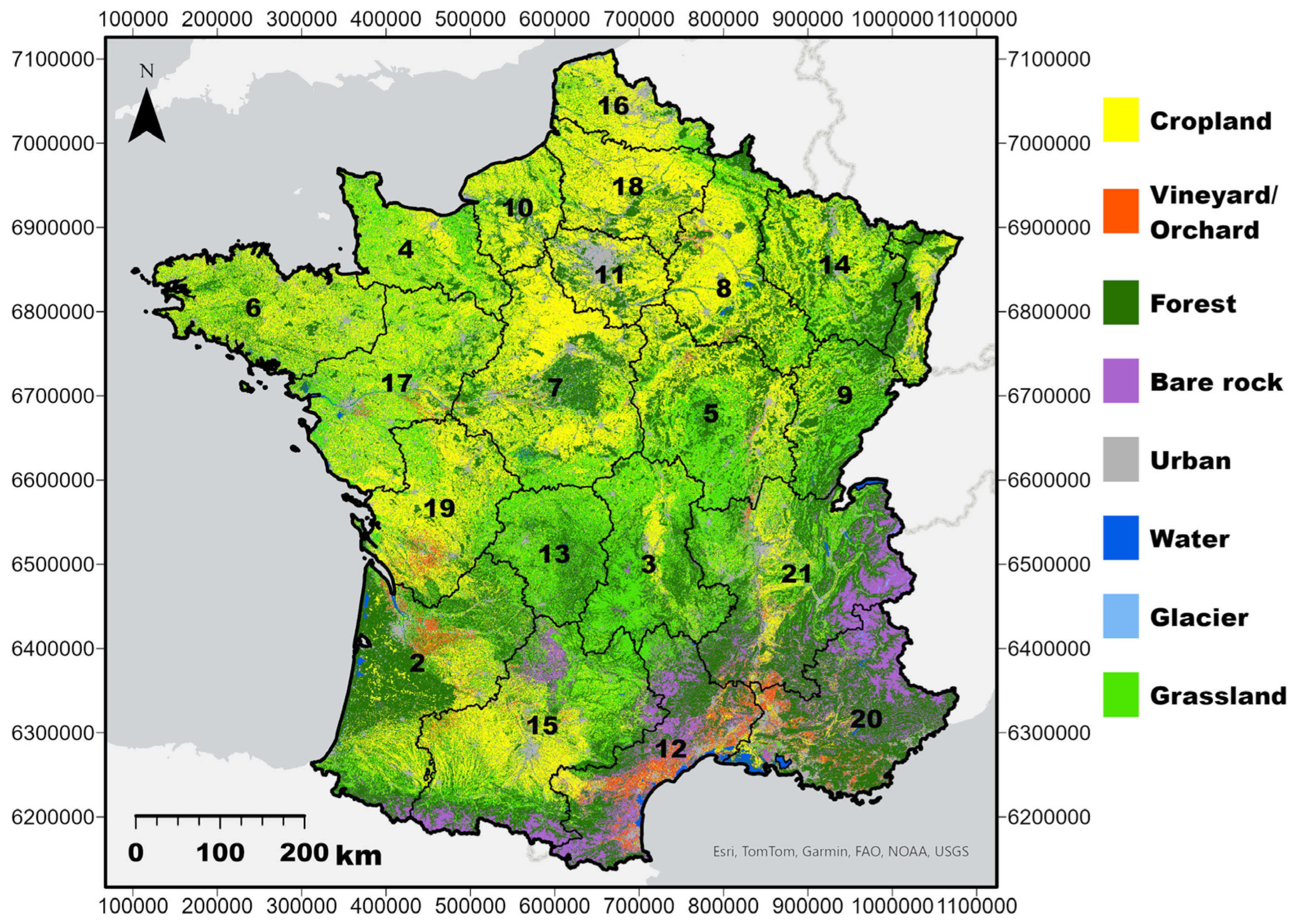


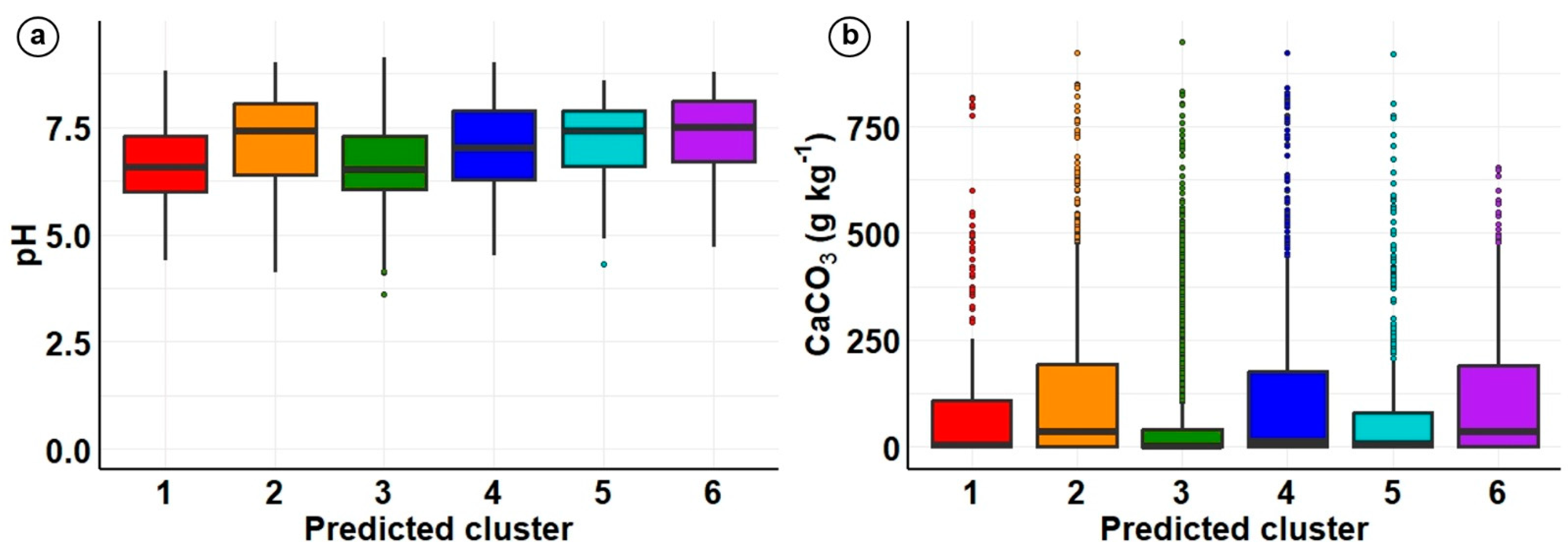
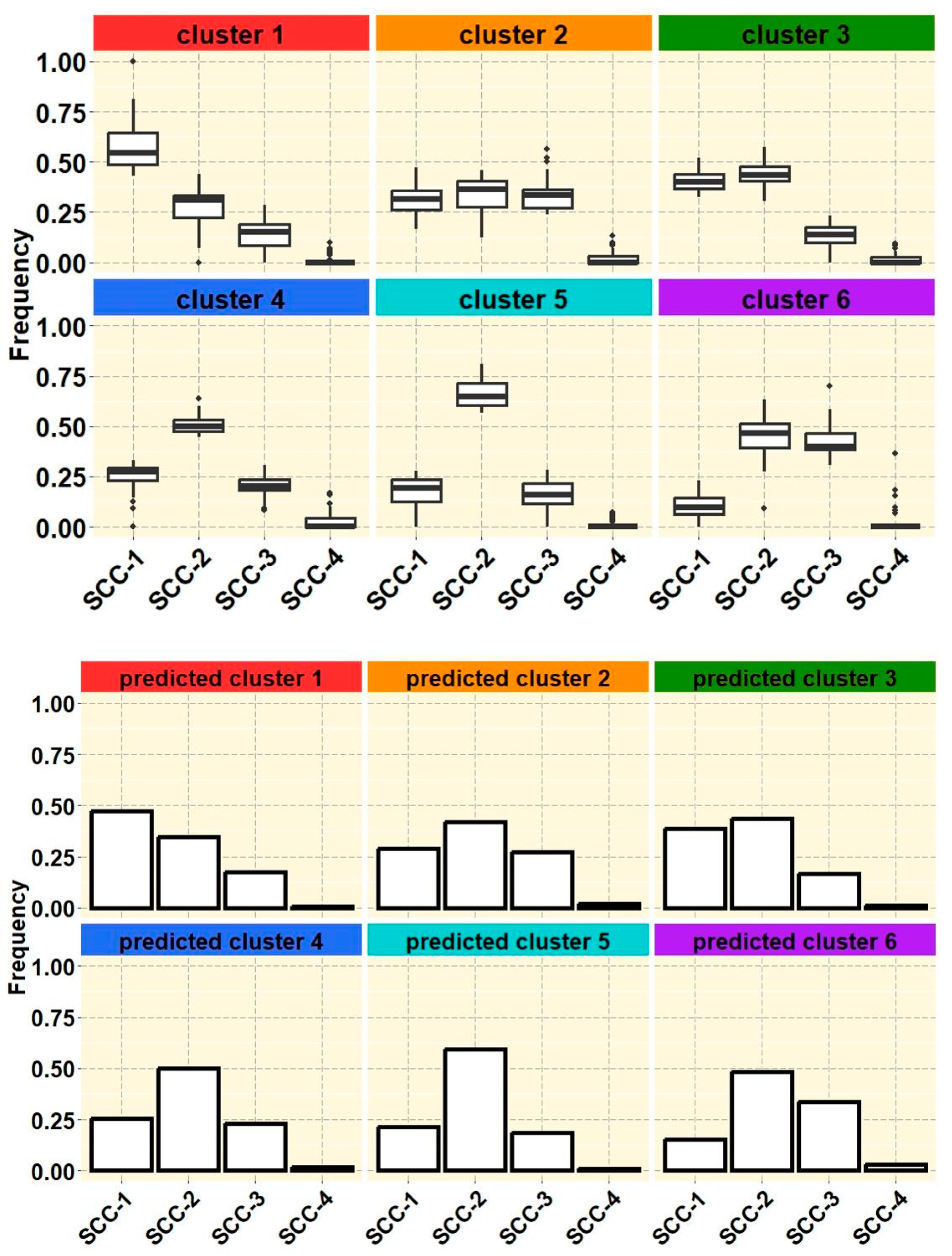

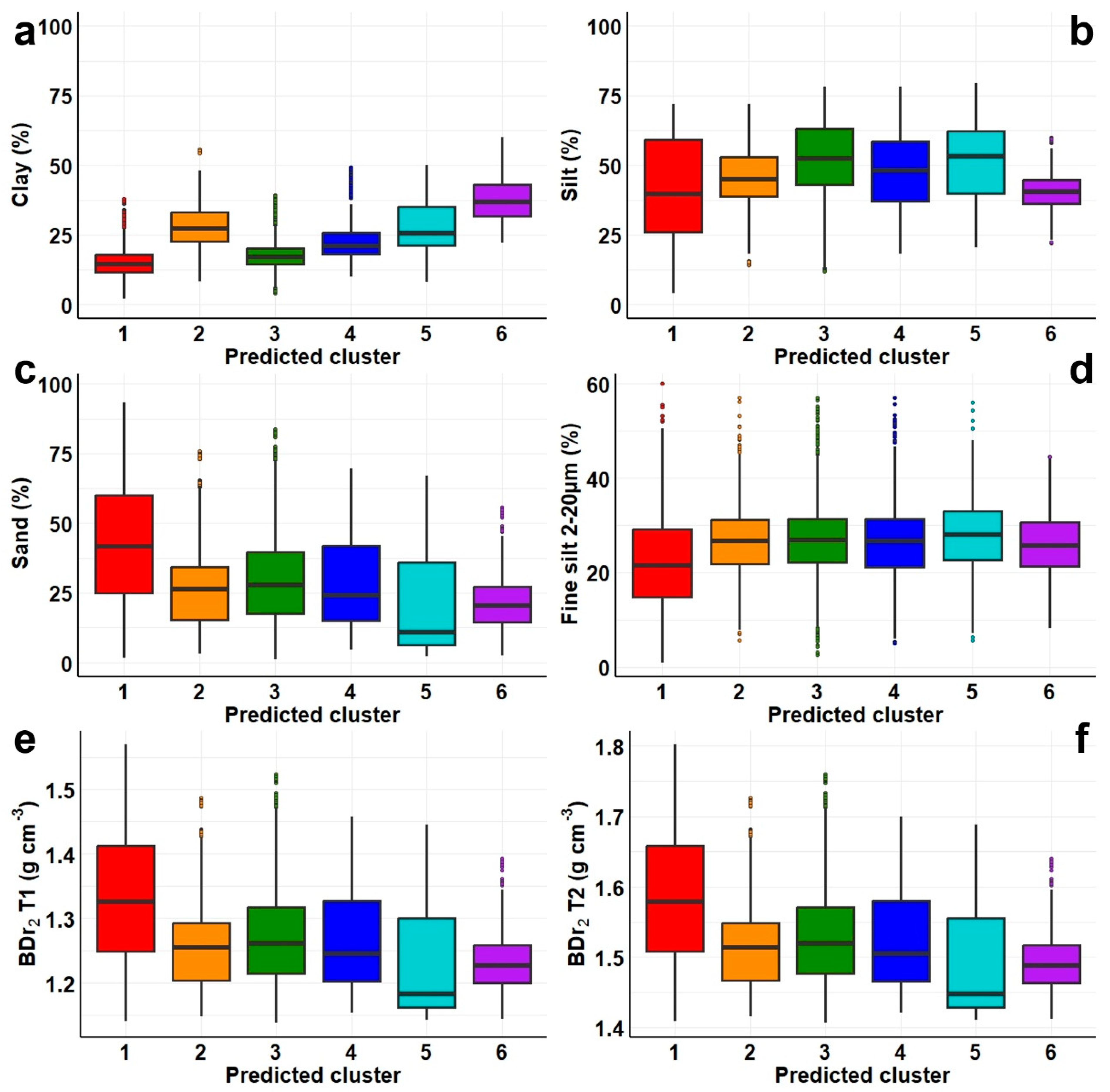
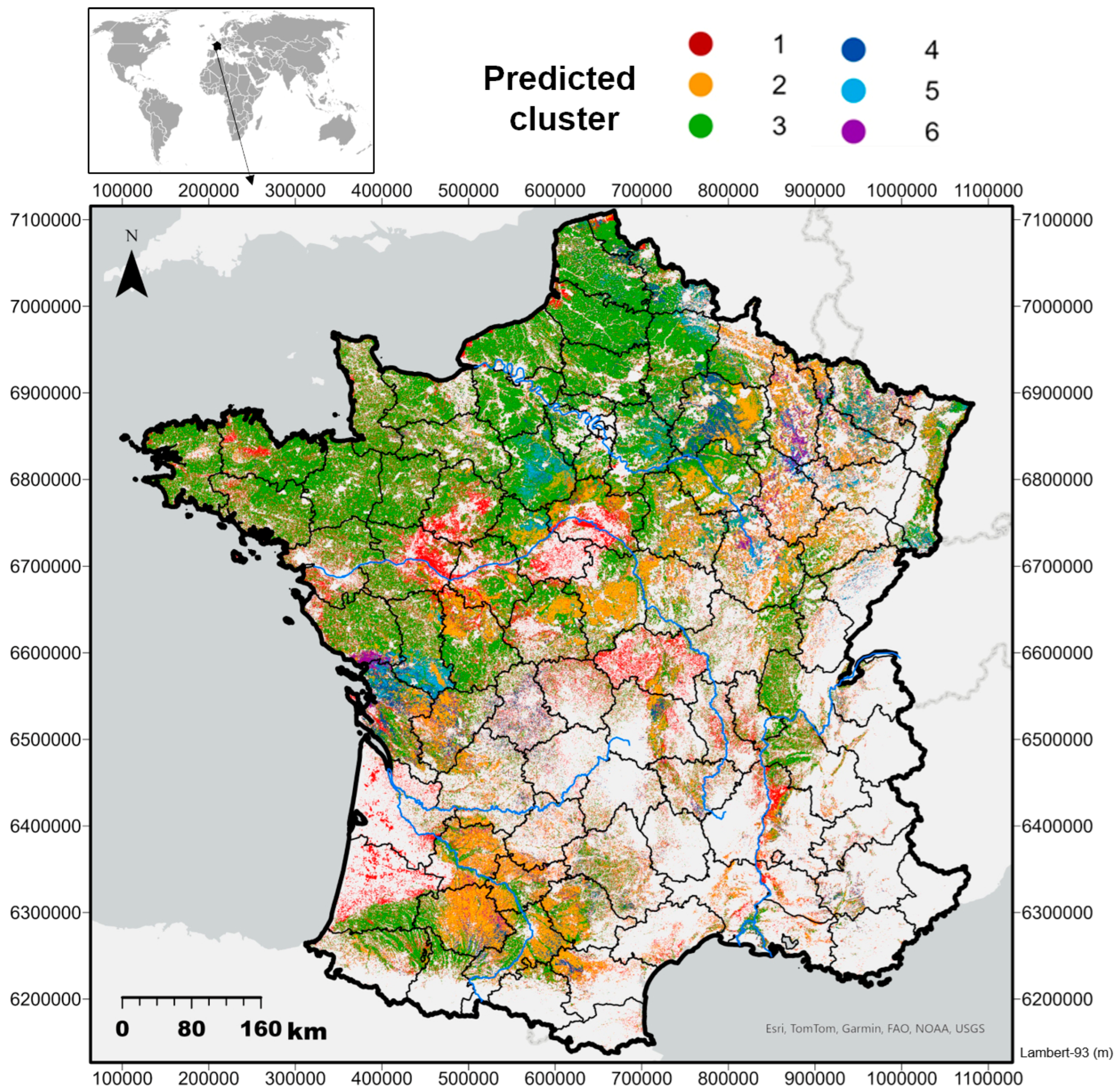
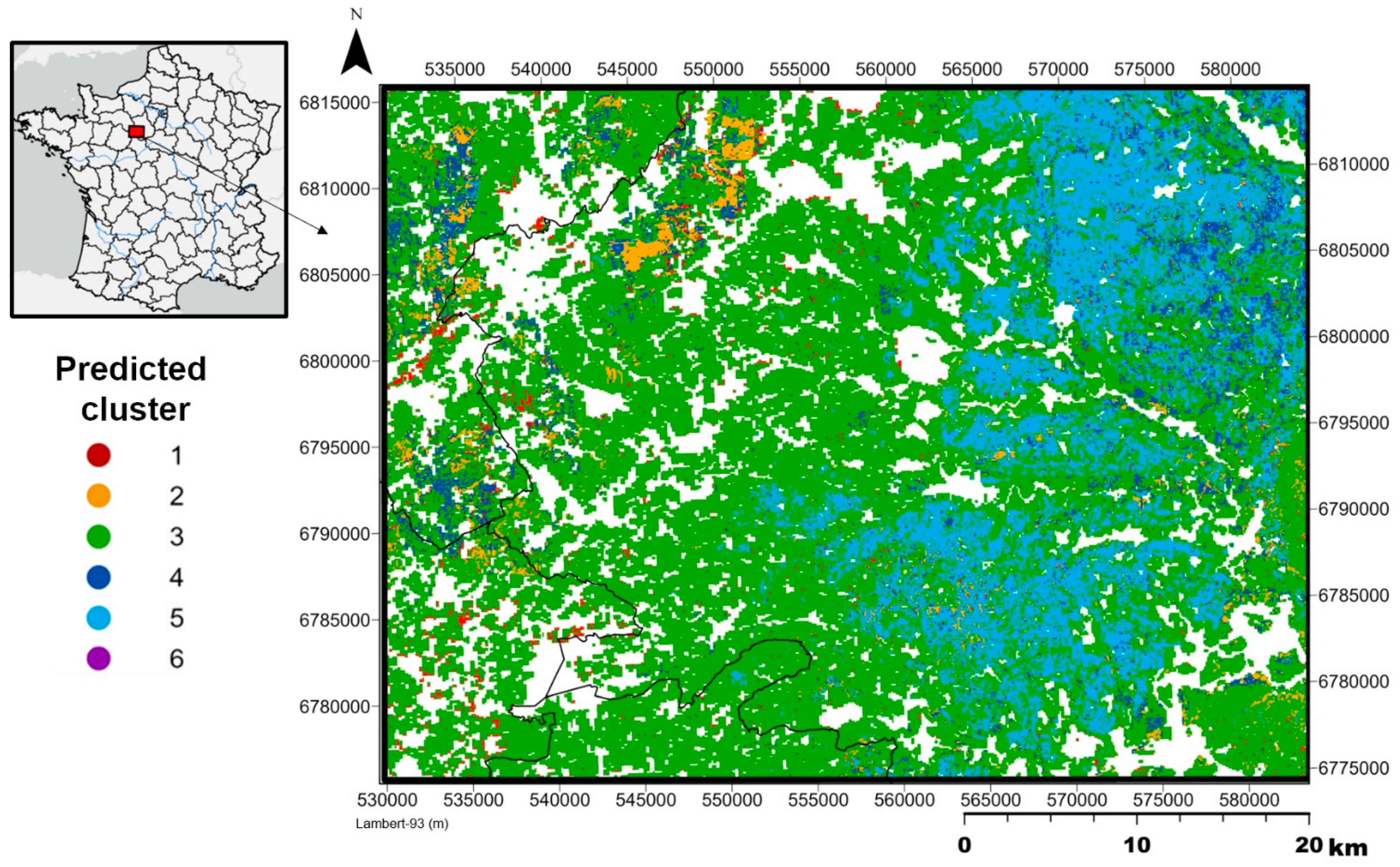

| Name | Covariate | Resolution | Unit | Reference |
|---|---|---|---|---|
| clay_GSM | Clay | 90 m | g kg−1 | GlobalSoilMap-France [63] |
| silt_GSM | Silt | 90 m | g kg−1 | GlobalSoilMap-France [63] |
| sand_GSM | Sand | 90 m | g kg−1 | GlobalSoilMap-France [63] |
| SOC_GSM | SOC | 90 m | g kg−1 | GlobalSoilMap-France [63] |
| ph_GSM | pHwater | 90 m | pH | GlobalSoilMap-France [63] |
| SOC/clay | SOC/clay ratio | 90 m | - | calculated from GlobalSoilMap-France [63] |
| SOC/SOCexp | SOC/SOCexp ratio | 90 m | - | calculated from GlobalSoilMap-France [63] |
| tmax | maximum annual temperature | 1 km2 | °C | WorldClim http://www.worldclim.org/ (accessed on 3 July 2024) |
| typo | climate typology | 90 m | 8 classes | [67] |
| geol | Soil parent material | 90 m | 9 classes | [68] |
| IDPR | Rate of river network development and persistence | 1:50 K | - | [69] |
| SRTM | Elevation | 90 m | m | SRTM (Shuttle Radar Topography Mission), [70] |
| OCS | Landscape Sentinel-2 2018 | 10 m | 23 classes | Theia OSO Land Cover Map [52] |
| STcell Cluster | Random Forest Cluster | Total | Recall% | |||||
|---|---|---|---|---|---|---|---|---|
| 1 | 2 | 3 | 4 | 5 | 6 | |||
| 1 | 309 | 101 | 764 | 93 | 29 | 8 | 1304 | 23.7 |
| 2 | 92 | 380 | 601 | 190 | 102 | 67 | 1432 | 26.5 |
| 3 | 338 | 306 | 3091 | 294 | 120 | 35 | 4184 | 73.9 |
| 4 | 86 | 228 | 775 | 264 | 78 | 37 | 1468 | 18.0 |
| 5 | 35 | 138 | 280 | 85 | 154 | 32 | 724 | 21.3 |
| 6 | 11 | 116 | 105 | 49 | 41 | 51 | 373 | 13.7 |
| Total | 871 | 1269 | 5616 | 975 | 524 | 230 | 9485 | |
| Recall% | 35.5 | 29.9 | 55.0 | 27.1 | 29.4 | 22.2 | OA = 45% | |
Disclaimer/Publisher’s Note: The statements, opinions and data contained in all publications are solely those of the individual author(s) and contributor(s) and not of MDPI and/or the editor(s). MDPI and/or the editor(s) disclaim responsibility for any injury to people or property resulting from any ideas, methods, instructions or products referred to in the content. |
© 2024 by the authors. Licensee MDPI, Basel, Switzerland. This article is an open access article distributed under the terms and conditions of the Creative Commons Attribution (CC BY) license (https://creativecommons.org/licenses/by/4.0/).
Share and Cite
Richer-de-Forges, A.C.; Arrouays, D.; Chen, S.; Libohova, Z.; Beaudette, D.E.; Bourennane, H. Mapping Topsoil Behavior to Compaction at National Scale from an Analysis of Field Observations. Land 2024, 13, 1014. https://doi.org/10.3390/land13071014
Richer-de-Forges AC, Arrouays D, Chen S, Libohova Z, Beaudette DE, Bourennane H. Mapping Topsoil Behavior to Compaction at National Scale from an Analysis of Field Observations. Land. 2024; 13(7):1014. https://doi.org/10.3390/land13071014
Chicago/Turabian StyleRicher-de-Forges, Anne C., Dominique Arrouays, Songchao Chen, Zamir Libohova, Dylan E. Beaudette, and Hocine Bourennane. 2024. "Mapping Topsoil Behavior to Compaction at National Scale from an Analysis of Field Observations" Land 13, no. 7: 1014. https://doi.org/10.3390/land13071014





